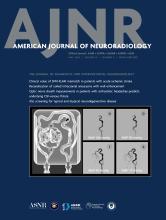This article requires a subscription to view the full text. If you have a subscription you may use the login form below to view the article. Access to this article can also be purchased.
Abstract
SUMMARY: An improved understanding of the cellular and molecular biologic processes responsible for brain tumor development, growth, and resistance to therapy is fundamental to improving clinical outcomes. Imaging genomics is the study of the relationships between microscopic, genetic, and molecular biologic features and macroscopic imaging features. Imaging genomics is beginning to shift clinical paradigms for diagnosing and treating brain tumors. This article provides an overview of imaging genomics in gliomas, in which imaging data including hallmarks such as IDH-mutation, MGMT methylation, and EGFR-mutation status can provide critical insights into the pretreatment and posttreatment stages. This article will accomplish the following: 1) review the methods used in imaging genomics, including visual analysis, quantitative analysis, and radiomics analysis; 2) recommend suitable analytic methods for imaging genomics according to biologic characteristics; 3) discuss the clinical applicability of imaging genomics; and 4) introduce subregional tumor habitat analysis with the goal of guiding future radiogenetics research endeavors toward translation into critically needed clinical applications.
ABBREVIATIONS:
- AI
- artificial intelligence
- CE
- contrast-enhanced
- DCE
- dynamic contrast-enhancement
- DMG
- diffuse midline glioma
- H3K27-DMG
- histone H3 lysine 27-altered diffuse midline glioma
- H3K27me3
- H3 lysine 27 trimethylation
- IVIM
- intravoxel incoherent motion
- LASSO
- least absolute shrinkage and selection operator
- PCA
- principal component analysis
- rCBV
- relative CBV
- TERT
- telomerase reverse transcriptase
- TME
- tumor microenvironment
- WHO
- World Health Organization
- © 2024 by American Journal of Neuroradiology







